|
The Brusilov Offensive
Cause | The Plan | Preparation | The Battle | Effects
Cause
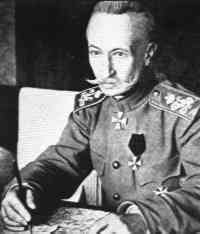
General Alexei Bruslilov
1853-1926
Appeals from France persuaded Russia into
launching a dual winged attack into Vilna Naroch as a counter
to German activity in Verdun. Instituted on 18-Mar-1916,
it ground to a halt in the mud of the spring thaw. German losses
of 20,000 men were nothing compared to the 70,000 - 100,000 lost
by the Russians. It did nothing to improve already low Russian
morale.
Later that spring the Austrians attacked
Italy at Trentino, bringing cries for help from the Italian government.
The Russian government saw an opportunity to re-establish their
previous military prestige and bolster public morale with a potentially
glorious victory. General Aleksei A. Brusilov organized and launched
this delayed, but still somewhat premature, surprise offensive
on 4-Jun-1916.
The Plan
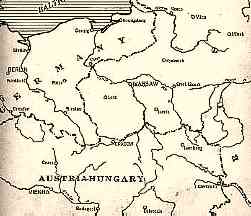
The Eastern Theater.
(click to zoom)
General Brusilov replaced General Ivanov on
14-Apr-1916 by order of the Czar Nicholas II. Brusilov proposed
an offensive to the Czar but the two other generals, Evert and
Kuroptkin, preferred to stay defensive in the war, claiming a
lack of heavy artillery and shell for an offensive. They argued
heatedly until the Czar agreed to give the go ahead for Brusilov's
Offensive. Brusilov had advised an attack on all fronts in light
of Germany's superior rail communication. The surprise attack would
be launched at the end of May and the southwestern front would make
the initial move with the main thrust following on the western
front towards Wilno. The southern front's objective was to take
Kovel, an important Austrian railway center. The four armies were
to be given six weeks of preparation time without obvious amassing
of troops or preliminary artillery preparation in order to preserve
the element of surprise. With four armies forming behind a 200
mile line sector, anticipating the main attack becomes very difficult.
Unfortunately, Brusilov's initial plan disintegrated (much like
the Schlieffen Plan) in the field.
Preparation
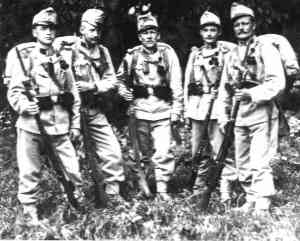
Austro-Hungarian marksmen of the Tiroler Kaiserjaeger
await action on the Eastern Front, 1916.
The original plan anticipated six weeks of
preparation time. This was not to be so. The Austro-Hungarian
line Brusilov intended to break through was solidly fortified.
One behind the other, three defensive belts lay. Each belt was
a minimum of three well-built, full-depth trenches including machine
gun nests, sniper hide-outs and communication tunnels dug 50-60
feet apart. Aerial photographs, courtesy of Russian aircraft,
provided an excellent view of these defenses and the information
transferred to a large-scale map. Officers studied the terrain
of the intended battle site. Most soldiers kept well behind the
line. The Russians dug their own trenches as assembly and jump
off points along the Austrian Front-line trenches. As Brusilov
readied his troops and the end of the month drew nearer, the pressure
began to mount. Then, just before the projected date of attack,
Evert announced his Western Front troops required more time for
further preparation. Brusilov was alarmed, to say the least, as
his Southwestern Army was only a preliminary diversion for Evert's
main Western offensive. The urgent situation at Verdun to the
West added further pressure on the success and swiftness of the
Russian offensive.
The Battle
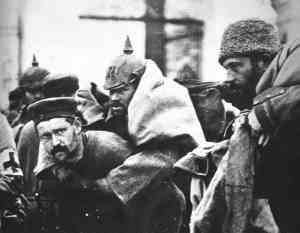
Russians bringing in wounded German POWs.
The surprise assault was launched on 4-Jun-1916. Three of the Russian armies broke through Austro-Hungarian
lines. The element of surprise, a thorough artillery prep and
the alacrity with which the Czechoslovakian soldiers of the Austrian
army surrendered fostered the Russian attempts. The thrust towards
Kovel and Lutsk succeeded in capturing the latter on 8-Jun.
By this time, the Austrians were in full and fast retreat. Mind
that this was just the preliminary attack. The stronger offensive
was to follow. No reserves had been constructed as the attack
was a wide spread, one-shot effort, not the typical hammer blow
assault. On 9-Jun, a very frustrated and distressed Brusilov
was informed that the Western attack was deferred until 18-Jun.
Evert was unwilling and hesitant to commence his maneuver. By
then, the German General Ludendorff, intent on reinforcing the
severely weakened Austrian army, had managed to scrape together
a counter attack. The preliminary main thrust split its advance
in two directions due to vague instruction from the GHQ. The chance
to take Kovel was lost. On 18-Jun, a small, poorly readied,
and futile front moved towards Baranowicze. This was Evert's long
awaited and much needed main thrust for which Brusilov's army
was only preliminary. It was then that Brusilov realized that
the Russian GHQ would do exactly what he had been so vehemently
opposed to. They transferred troops from Evert's Western Army
to Brusilov's Southwestern, assuming the additional troops would
assist in exploiting fully the success of his initial attack.
The German, making the best of rather meager resources, noticed
the move of troops and prepared a counter to the south. Because
of their superior rail, they arrived first. And the battle continued.
By the end of July, very little progress had been made in spite
of renewed attempts. Austrian, German and Russian armies began
to tire. With Russian casualties numbering more than half a million,
the Offensive ground to a halt on 10-Aug-1916. But the effort
was not entirely in vain. Austria had lost extensive territory
and, excluding the dead and wounded, 375,000 as POW's.
Effects
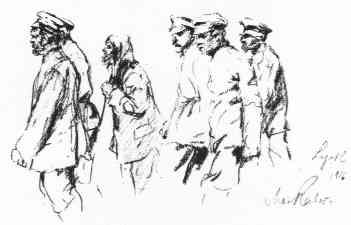
Russian POWs by German artist Max Rabes, 1916.
The Brusilov Offense had quite an effect on
the course of history. Strategically, it weakened the Central
Powers on the Italian front and at Verdun. The Austrians were forced to forsake
their Italian victory, rushing to fight the Russian in the North.
An important factor on the Western Front, the Eastern attacks
saw Germany terminating its Verdun Operation to transfer no less
than 35 divisions from the Schlieffen right hook to the Eastern
Front. This helped to sufficiently undermine Schlieffen plan enough
for France to sustain a successful defense. The Offense ruined
Austria-Hungary. Weakened by political turmoil, Austria was unable
to cope with its losses, of funds and of soldiers. It was forever
eliminated as a major military power. The future brought the collapse
of the Habsburg Empire and the formation of the Austrian and
Hungarian republics.
Within its own, the loss of one million Russian
soldiers and the decayed public morale hung heavily on the people.
Widespread famine caused by the diversion of all resources to
the war effort induced rioting. Nicholas II abdicated from the
throne and the provisional government, set up in his place, was
overthrown in a Bolshevik coup abruptly afterwards. In 1917 the
Russian Revolution was well under way. A failed success, the Offense
assisted the Allied war effort but brought upon itself much strife.
© 1996 Grace Yoshizawa - All rights reserved
|